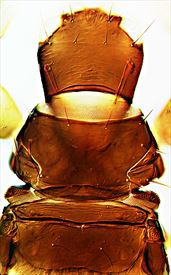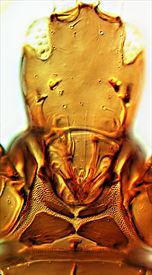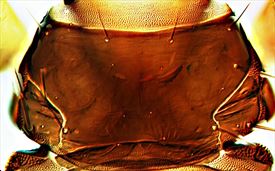
Antenna

Head & thorax

Prosternites and ventral view of eyes

Pronotum

Meso & metanotum, pelta & tergite II

Meso & metanotum, pelta & tergite II
Distinguishing features
Both sexes usually wingless, female sometimes fully winged. Abdomen dark brown, head and thorax commonly yellowish, legs usually yellow; antennal segments I–IV usually yellow, distal segments brown; major setae brown, fore wing deeply shaded. Head wider than long, narrowed to base, eyes prolonged on ventral surface; one pair of ocellar setae arising between posterior ocelli, postocular setae finely pointed, about as long as eye; maxillary stylets broad, not retracted to postocular setae, wide apart and V-shaped. Antennae 8-segmented; segment III with 2 slender sensoria, IV with 4 sensoria; segment VIII slender and narrowed to base. Pronotum with five pairs of bluntly pointed major setae; epimeral sutures complete; basantra weakly sclerotized, ferna and mesopresternum transverse. Fore tarsi with no tooth. Metanotum with no sculpture medially. Fore wing parallel sided, broad, with no duplicated cilia. Pelta variable, broad with prominent and often separated lateral wings; tergites with one pair of sigmoid wing-retaining setae, weak in apterae; tergite IX setae pointed, shorter than tube; tube shorter than head.
Male usually wingless, very rarely winged. Large males with fore tarsal tooth large, and fore femora swollen.
Related species
The genus Nesothrips includes 31 species, of which 6 are endemic to New Zealand, 13 are from Australia, 9 described from various Pacific islands, and 3 from southeast Asia. Nesothrips species usually have a rather short head, with a pair of setae between the hind ocelli, and the maxillary stylets wide apart. The ventral prolongation of the eyes in N. propinquus is unusual in that it involves more than a single row of ommatidia.
Biological data
Feeding by imbibing fungal spores, particularly at the base of tussocks of grasses, but also found on dead twigs.
Distribution data
Widespread from New Zealand and southern Australia along the old sailing-ship route to Europe, including South Africa and islands in the Atlantic; also in California. Found widely in New Zealand, where it possibly originated (ND, AK, CL, WO, BP, GB, TO, TK, HB, WI, WN / SD, NN, MB, KA, BR, WD, MC, SC, CO, MK, DN, SL / Chatham Is.).
Family name
PHLAEOTHRIPIDAE, IDOLOTHRIPINAE
Species name
Nesothrips propinquus (Bagnall)
Original name and synonyms
Oedemothrips propinquus Bagnall, 1916: 408
Cryptothrips dimidiatus Hood, 1918: 145
Bagnalliella cestosa Karny, 1920: 41
Oedemothrips propinquus var. breviceps Bagnall, 1924: 634
Oedemothrips propinquus f. obscuricornis Bagnall, 1924: 634
Neosmerinthothrips oleriae Moulton. 1949: 492
Bolothrips similis Hartwig, 1948: 103
References
Eow LX, Mound LA, Tree DJ, Cameron SL (.2014) Australian species of spore-feeding Thysanoptera in the genera Carientothrips and Nesothrips (Phlaeothripidae: Idolothripinae). Zootaxa 3821 (2): 193–221.
Mound LA (1974) Spore-feeding thrips (Phlaeothripidae) from leaf litter and dead wood in Australia. Australian Journal of Zoology (supplement) 27: 1–106
Mound LA (1974) The Nesothrips complex of spore-feeding Thysanoptera (Phlaeothripidae: Idolothripinae). Bulletin of the British Museum (Natural History), Entomology 31: 107–188.
Mound LA & Walker AK (1986) Tubulifera (Insecta: Thysanoptera). Fauna of New Zealand 10: 1–140.